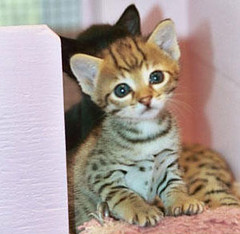A show-quality Persian has an extremely long thick coat, short legs, a wide head with the ears set far apart, large eyes, and an extremely foreshortened muzzle. The breed was originally established with a short (but not non-existent) muzzle, but over time this feature has become extremely exaggerated, particularly in North America, and Persians with the more extreme brachycephalic head type are prone to a number of health problems (specifically affecting their sinuses and breathing) caused by it. However, conscientious breeders eliminate this by careful choice of breeding stock with more moderate head type, as the stated goal of most breeders is first and always healthy cats.
Keeping them indoors is the best policy if you want to preserve their coat. You should ensure regular bathing and daily brushing of the coat with a metal comb.
The Persian breed is popular because it is gentle and sweet and have a pleasant voice. They love attention and love being admired. Unlike other cats, they don’t climb and jump much at all.
To ensure that your Persian pet stays healthy, you should always take him to the vet on an annual basis. If cared for properly, such as grooming, shots, and checkups, Persian cats can live as long as 20 years. One thing you’ll need to be aware of that’s common with Persians is their eyes. Their eyes are very big and can sometimes be too much for the cat to clean. This is a common healthy problem with the breed, and should be checked on a regular basis to ensure that it doesn’t get out of control.
You can expect a life span of almost 0 years for your Persian cat if you take proper medical care like regular check up with a Vet, at least once a year. Eyes need special attention.
When you compare Persians to other breeds, you’ll notice that the Persians are among the easiest to keep. You don’t have to worry about things like jumping or climbing, as Persians don’t like to do either. All you’ll need to do is feed your cat and groom him or him on a daily basis. Even though grooming can be quite a bit of work in the long run – it’s well worth it when you have a healthy an beautiful Persian cat.
If you want learn more about cat, make sure you visit this website of my suggestion:
http://cat-world.50webs.com
Idham Effendi
mail: chip_arm@yahoo.com
website:http://cat-world.50webs.com
Article Source: http://EzineArticles.com/?expert=Idham_Effendi
Tuesday, April 28, 2009
Friday, April 24, 2009
Caring For Persian Cats
Persian cats are among the most popular breeds of cat in America, today. Well known for their gentle, sweet personalities and their long hair, Persian cats are also great companions for virtually anyone, and need very little attention.
Persian cats actually come in a variety of colors. They are divided into seven color divisions: solid, silver and gold, tabby, shaded and smoke, particolor, bicolor and Himalayan. No matter what color of Persian cat it may be, they are best noticed during competitions by their long and flowing coats.
Persian cats are not great outdoor cats. Because of their long hair, if left outside for any length of time in weather, their coats can become seriously matted and damaged.
Most short-haired cats have no problem maintaining their own coats through daily self grooming, but this is not so for long-haired Persian cats. It is a good idea to brush
the cat's hair daily or as often as possible. When Persian cats is very young, it is a good idea to start bathing on a regular basis with recommended shampoos, in order to
keep the coat healthy, clean and mat-free.
Another thing that’s common with Persians cats is their eyes. Their eyes are very big and can sometimes be too much for the cat to clean. You'll notice a lot of matting of the hair around the eyes when there is a problem. This is a common health problem with the breed, and should be checked on a regular basis to ensure that it doesn’t get out of control.
The Persian breed is gentle and sweet, getting along great with everyone including kids. They have a pleasant meow and using their meow and their eyes they are able to communicate very effectively with their owners. They are very playful, loved being admired and thought they do not require a lot of attention, they do love it. As with
most cats, the majority of the time, Persian cats love to bask in the sun and show others just how beautiful they truly are.
Although most breeds can be kept indoors or outside, Persian cats should always be kept inside and only allowed to go outside of the house with supervision. Keeping them inside will help protect their coats and also keep diseases and common parasites away from them as well.
To ensure that your Persian cat stays healthy, you should always take him to the vet on an annual basis. With lots of love and a little attention to grooming, Persian cats can live as long as 20 years.
Copyright © 2007 Will Jones
Will is a retired Research Food Technologist who worked over forty years with a major Fortune 500 food company in the Midwest. Product and process development of various types of foods were Will’s expertise. Will’s interests include reading, cooking, fishing, travel and golf.
Will is also a contributing editor for http://www.best-free-help.com a FREE Informational Website Portal that is dedicated to giving people expert knowledge of real value, to help people them decide!
Article Source: http://EzineArticles.com/?expert=Will_Jones
Persian cats actually come in a variety of colors. They are divided into seven color divisions: solid, silver and gold, tabby, shaded and smoke, particolor, bicolor and Himalayan. No matter what color of Persian cat it may be, they are best noticed during competitions by their long and flowing coats.
Persian cats are not great outdoor cats. Because of their long hair, if left outside for any length of time in weather, their coats can become seriously matted and damaged.
Most short-haired cats have no problem maintaining their own coats through daily self grooming, but this is not so for long-haired Persian cats. It is a good idea to brush
the cat's hair daily or as often as possible. When Persian cats is very young, it is a good idea to start bathing on a regular basis with recommended shampoos, in order to
keep the coat healthy, clean and mat-free.
Another thing that’s common with Persians cats is their eyes. Their eyes are very big and can sometimes be too much for the cat to clean. You'll notice a lot of matting of the hair around the eyes when there is a problem. This is a common health problem with the breed, and should be checked on a regular basis to ensure that it doesn’t get out of control.
The Persian breed is gentle and sweet, getting along great with everyone including kids. They have a pleasant meow and using their meow and their eyes they are able to communicate very effectively with their owners. They are very playful, loved being admired and thought they do not require a lot of attention, they do love it. As with
most cats, the majority of the time, Persian cats love to bask in the sun and show others just how beautiful they truly are.
Although most breeds can be kept indoors or outside, Persian cats should always be kept inside and only allowed to go outside of the house with supervision. Keeping them inside will help protect their coats and also keep diseases and common parasites away from them as well.
To ensure that your Persian cat stays healthy, you should always take him to the vet on an annual basis. With lots of love and a little attention to grooming, Persian cats can live as long as 20 years.
Copyright © 2007 Will Jones
Will is a retired Research Food Technologist who worked over forty years with a major Fortune 500 food company in the Midwest. Product and process development of various types of foods were Will’s expertise. Will’s interests include reading, cooking, fishing, travel and golf.
Will is also a contributing editor for http://www.best-free-help.com a FREE Informational Website Portal that is dedicated to giving people expert knowledge of real value, to help people them decide!
Article Source: http://EzineArticles.com/?expert=Will_Jones
Labels:
Persian
Thursday, April 23, 2009
The Persian Cat
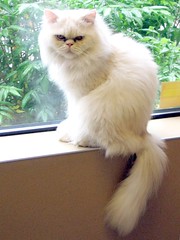 The Persian is one of the oldest cats in existence, with records of its presence dating back to times of Pharaohs in Egypt. It is generally believed though that the cat originated in Persia, now known as Iran. They were brought over to Europe centuries ago though it was not until the later half of the nineteenth century that their fame truly began to spread. In United Kingdom they are called Persian Longhairs or simply Longhairs. A felid without an established pedigree is referred to simply as Domestic Longhair Cat.
The Persian is one of the oldest cats in existence, with records of its presence dating back to times of Pharaohs in Egypt. It is generally believed though that the cat originated in Persia, now known as Iran. They were brought over to Europe centuries ago though it was not until the later half of the nineteenth century that their fame truly began to spread. In United Kingdom they are called Persian Longhairs or simply Longhairs. A felid without an established pedigree is referred to simply as Domestic Longhair Cat.Over the years, through selected breeding the appearance of Persian cats has changed quite a bit from the time when they were first introduced to the rest of the world. Their traditional doll face has been developed into a shortened muzzle and flattened high nose. Coat has become more and more thick and long with a variety of colors and patterns include silver, gold, tabby, solid and bicolors. Body is cobby with short and strong legs and round head. Eyes are big and expressive and ears low and widely set.
Though they are highly sought for their beauty, the Persians also suffer from some health issues. Their long silky double layered coat frequently gets matted and requires regular washing, drying and combing to prevent tangles and hairballs. The modern flat-faced Persians frequently develop respiratory problems owing to their flattened nose that obstructs breathing as well as the tear ducts, meaning that their eyes and nose require daily wiping to clean away crusts. Some Persians develop Polycystic Kidney Disease as well. Responsible breeders though are making efforts to preserve the health of this splendid cat above all.
Persians are the most gentle and docile of all cats. They are very affectionate and tolerant animals who fare best in a peaceful, loving environment. It is best to keep them as indoor pets to free their long exuberant fur from parasites even as they have been occasionally reported by some to be surprisingly good hunters.
The author is a blogger about cats and an expert on Persian cats.
Article Source: http://EzineArticles.com/?expert=Omer_Ashraf
Labels:
Persian
Tuesday, April 21, 2009
Information Regarding the Somali Cat
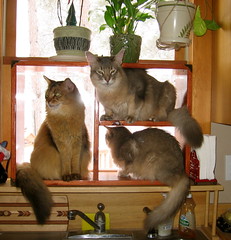
Somali is a domestic feline that resembles an Abyssinian in nearly every way apart from its longer fur. This is owing to the fact that Somalis originated from Abyssinians nearly half a century back. Theirs is an artificially created breed that began in ninety sixties when some longhair kittens were noticed in an Abyssinian litter. Normally these were seen as an undesirable feature by breeders for show class cats, and thus these animals were sold off as pets. With time, some people began to take interest in these pretty felines and started their development in earnest. Over the next couple of decades acceptance came from registering bodies. Today Somali is recognized as a breed in most parts of the world though it is not common everywhere.
Somali is medium in its size, body and appearance. It is relatively lithe but muscular with an elegant design. Fur is long and made prominent in a bushy tail and often in a ruff around neck. It is quite soft and occurs in a number of colors, with ruddy being the commonest, including fawn, lilac, blue, silver, cream and chocolate though not all colors are recognized everywhere. Individual hair are ticked and often have multiple color bands along their length. Eyes are lined with darkish color and perioral area is white. Owing to their wild looks and fluffy tails Somalis are often called 'fox cats'.
Owing to persistent inbreeding over time, Somalis have developed certain genetic defects in some of their lines. These include dental, blood and biochemical disorders. There are efforts underway to eradicate these through breeding and propagation of only healthy genes. Generally though these cats are quite healthy and in fact easier to handle than most longhairs since they shed very little. They lose their hair altogether once or twice an year and don't shed continuously.
Somalis are playful and interactive cats who love to participate in all chores and activities of their humans. Loving animals, they are quick to adjust to a multi-pet household with children. All they require is some space, love and attention from their humans.
The author is a blogger about cats and an expert on Somali cat.
Article Source: http://EzineArticles.com/?expert=Omer_Ashraf
Omer Ashraf - EzineArticles Expert Author
Labels:
Somali
Sunday, April 19, 2009
Bengal Cats
 Bengal cats are a new breed, cross-bred with a wildcat. Their spotted or marbled coat is soft and thick, they have a large, sleek muscular build, rounded slighted long face, oval eyes and thick tail. They have an enviable, exotic appearance without the wild temperament of their much larger untamed ancestors.
Bengal cats are a new breed, cross-bred with a wildcat. Their spotted or marbled coat is soft and thick, they have a large, sleek muscular build, rounded slighted long face, oval eyes and thick tail. They have an enviable, exotic appearance without the wild temperament of their much larger untamed ancestors.Characteristics
Bengal came from the taxonomic name of the Asian Leopard Cats (ALC) and not from the more widely known Bengal Tiger species, which is unrelated to the Bengal Cats ancestry. These cats have a series of horizontal stripes on their faces, known as mascara, which extend along the eye to the back of the neck. Their back and sides are marked with spots like those of a jaguar, and the rest of the body, legs and tail, are marked with symmetrical stripes. The spots sometimes have a marbled appearance and are generally made up of two colors. The following colors and patterns are recognized as Bengal Cats and therefore eligible for competition; Brown Spotted Tabby, Brown Marbled Tabby, Seal Mink Spotted Tabby, Seal Mink Marbled Tabby, Seal Sepia Spotted Tabby, Seal Sepia Marbled Tabby, Seal Spotted Lynx Point, and Seal Marbled Lynx Point. These pets are the only variety that sometimes have a pearl or gold dusting, sometimes called glitter, and the texture of their fur is rich and silky-smooth. Bengal Cats even have a different sound in their voice and tend to be very vocal.
Temperament
Originally some of the Bengal Cats inherited the unpredictable temperament of the wildcat, but breeding programs concentrated on breeding a gentler nature. The domestic feline is very lively and active, but also quite self-contained and quiet.
Brief History
As the story goes, Jean Sugden Mills, around 1982 bred a domestic cat with a feral Indian Mau. At about the same time, Greg and Elizabeth Kent started their own breed of Bengal Cats using an Egyptian Mau. Both Jean Mills the Kents worked hard to popularize the this breed, and in 1986, The International Cat Association adopted the first written breed standard. Today Bengal Cats are the most popular registered cat breed.
Care and grooming of Bengal Cats ought to be kept up as any other housecat; frequent combing of fur, good nutrition, regular play and veterinary visits. For more information on the care and feeding of our favorite furry pets, visit: http://lovefatcats.com
Article Source: http://EzineArticles.com/?expert=Elsa_Albro
Labels:
Bengal
Friday, April 17, 2009
Cat Breed - Balinese
The Balinese, an oriental cat, was named after the graceful, traditional Balinese dancers that it resembled. It is really identical to its feline cousin, the Siamese, being a spontaneous mutation in a Siamese litter in the U.S. back in the 1950's, except it has a longer coat; it looks like a Himalayan cat but is not as fluffy.
The Balineses' former name was the 'Longhair Siamese' and it was first registered as a breed in the U.S. in 1963; it now comes in two distinct kinds; the apple-headed traditional version, similar to a Ragdoll cat, and the contemporary variety, with a much shorter coat and is virtually the same as a Siamese except for its plume like tail. There is also a relatively rare short-haired variant.
Because of its longer coat, the Balinese seems to have softer lines. Its long, straight head is in the shape of a tapering wedge, ideally, its skull is flat. It has a well-muscled, elegant, medium sized body, with light but strong structure; the males weigh from 12-16 pounds (lbs), and the females are a bit lighter at 8-12 pounds.
The Balinese's ears are often strikingly large, pointed and wider at the base. They have tear-drop shaped, medium-sized eyes, which are neither recessed nor protruding. Eye color comes in various tints of blue, in sapphire hues, the deeper the shade the better!
The nose is long and straight, a continuation of the forehead with no break; their muzzle is fine and wedge-shaped. Paws are usually dainty, small and oval. They have a long, thin, dense, clearly defined tail which tapers down to a fine point; the hairs, which are longest on the tail than other parts of the body, spread out like a feather.
The ermine coat of the Balinese is of medium length, fine and silky; they do not have a downy undercoat like many other breeds. The coat lies close to the body and may appear shorter than it is. They have points on the mask, ears, legs, feet; there is no ticking or white hairs in the points. Coat colors are same as the Siamese and include: seal, chocolate, lilac, and blue as well as less traditional colors such as cream and red. Coat patterns include styles such as the lynx (tabby) point and tortie point.
The Balinese's body is graceful, extended and svelte, with a long and slender neck and they have a majestic, regal bearing to them. Their body structure is a distinctive combination of fine bones and firm muscles. Shoulders and hips have the identical sleek lines of their tubular bodies. Hips are rarely wider than the shoulders, and they have a tight abdomen; their legs are long and slim, hind legs higher than the front. The male Balinese is usually somewhat larger than the female.
Balineses' do not usually require a lot of grooming, just an occasional brush or comb; routine nail cutting and good mouth hygiene is essential! Generally speaking, they are a fairly low maintenance cat.
Personality wise, they have an, outgoing, extroverted, extraordinarily loving and friendly temperament and bond closely with their owners. Making excellent pets, they enjoy fun and games and the indoor life and are cuddly and affectionate! Playfulness is a marked trait of this breed. Gregariousness prevails, similar to their Siamese relatives and they love to live in groups; they are quite vocal but have a softer voice than that of the Siamese cat.
The Balinese is highly intelligent, interactive, and can be quite demanding when it is seeking attention! They are easy-going cats and are not difficult to train; renowned mischief makers when they are bored, they love toys and will make anything and everything in to one! They will even play fetch, just like a dog would but won't tolerate mistreatment from others!
They need a good diet and plenty of exercise; generally speaking, they are very healthy cats and have few serious problems; sometimes furballs or hairballs can be an issue; lifespan is 10 -14 years.
This breed of cat is suitable for families with children and elderly people too. The Balinese gets along with other family members, as well as other pets, and have even been known to cosy up with the family dog on occasions!
For more informative cat articles, and for a large array of cat products and toys, Please visit: http://fatherspirit-catablog.blogspot.com/
Article Source: http://EzineArticles.com/?expert=David_Braybrooke
The Balineses' former name was the 'Longhair Siamese' and it was first registered as a breed in the U.S. in 1963; it now comes in two distinct kinds; the apple-headed traditional version, similar to a Ragdoll cat, and the contemporary variety, with a much shorter coat and is virtually the same as a Siamese except for its plume like tail. There is also a relatively rare short-haired variant.
Because of its longer coat, the Balinese seems to have softer lines. Its long, straight head is in the shape of a tapering wedge, ideally, its skull is flat. It has a well-muscled, elegant, medium sized body, with light but strong structure; the males weigh from 12-16 pounds (lbs), and the females are a bit lighter at 8-12 pounds.
The Balinese's ears are often strikingly large, pointed and wider at the base. They have tear-drop shaped, medium-sized eyes, which are neither recessed nor protruding. Eye color comes in various tints of blue, in sapphire hues, the deeper the shade the better!
The nose is long and straight, a continuation of the forehead with no break; their muzzle is fine and wedge-shaped. Paws are usually dainty, small and oval. They have a long, thin, dense, clearly defined tail which tapers down to a fine point; the hairs, which are longest on the tail than other parts of the body, spread out like a feather.
The ermine coat of the Balinese is of medium length, fine and silky; they do not have a downy undercoat like many other breeds. The coat lies close to the body and may appear shorter than it is. They have points on the mask, ears, legs, feet; there is no ticking or white hairs in the points. Coat colors are same as the Siamese and include: seal, chocolate, lilac, and blue as well as less traditional colors such as cream and red. Coat patterns include styles such as the lynx (tabby) point and tortie point.
The Balinese's body is graceful, extended and svelte, with a long and slender neck and they have a majestic, regal bearing to them. Their body structure is a distinctive combination of fine bones and firm muscles. Shoulders and hips have the identical sleek lines of their tubular bodies. Hips are rarely wider than the shoulders, and they have a tight abdomen; their legs are long and slim, hind legs higher than the front. The male Balinese is usually somewhat larger than the female.
Balineses' do not usually require a lot of grooming, just an occasional brush or comb; routine nail cutting and good mouth hygiene is essential! Generally speaking, they are a fairly low maintenance cat.
Personality wise, they have an, outgoing, extroverted, extraordinarily loving and friendly temperament and bond closely with their owners. Making excellent pets, they enjoy fun and games and the indoor life and are cuddly and affectionate! Playfulness is a marked trait of this breed. Gregariousness prevails, similar to their Siamese relatives and they love to live in groups; they are quite vocal but have a softer voice than that of the Siamese cat.
The Balinese is highly intelligent, interactive, and can be quite demanding when it is seeking attention! They are easy-going cats and are not difficult to train; renowned mischief makers when they are bored, they love toys and will make anything and everything in to one! They will even play fetch, just like a dog would but won't tolerate mistreatment from others!
They need a good diet and plenty of exercise; generally speaking, they are very healthy cats and have few serious problems; sometimes furballs or hairballs can be an issue; lifespan is 10 -14 years.
This breed of cat is suitable for families with children and elderly people too. The Balinese gets along with other family members, as well as other pets, and have even been known to cosy up with the family dog on occasions!
For more informative cat articles, and for a large array of cat products and toys, Please visit: http://fatherspirit-catablog.blogspot.com/
Article Source: http://EzineArticles.com/?expert=David_Braybrooke
Labels:
Balinese
Cat Breed - Balinese
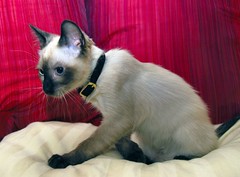 The Balinese, an oriental cat, was named after the graceful, traditional Balinese dancers that it resembled. It is really identical to its feline cousin, the Siamese, being a spontaneous mutation in a Siamese litter in the U.S. back in the 1950's, except it has a longer coat; it looks like a Himalayan cat but is not as fluffy.
The Balinese, an oriental cat, was named after the graceful, traditional Balinese dancers that it resembled. It is really identical to its feline cousin, the Siamese, being a spontaneous mutation in a Siamese litter in the U.S. back in the 1950's, except it has a longer coat; it looks like a Himalayan cat but is not as fluffy.The Balineses' former name was the 'Longhair Siamese' and it was first registered as a breed in the U.S. in 1963; it now comes in two distinct kinds; the apple-headed traditional version, similar to a Ragdoll cat, and the contemporary variety, with a much shorter coat and is virtually the same as a Siamese except for its plume like tail. There is also a relatively rare short-haired variant.
Because of its longer coat, the Balinese seems to have softer lines. Its long, straight head is in the shape of a tapering wedge, ideally, its skull is flat. It has a well-muscled, elegant, medium sized body, with light but strong structure; the males weigh from 12-16 pounds (lbs), and the females are a bit lighter at 8-12 pounds.
The Balinese's ears are often strikingly large, pointed and wider at the base. They have tear-drop shaped, medium-sized eyes, which are neither recessed nor protruding. Eye color comes in various tints of blue, in sapphire hues, the deeper the shade the better!
The nose is long and straight, a continuation of the forehead with no break; their muzzle is fine and wedge-shaped. Paws are usually dainty, small and oval. They have a long, thin, dense, clearly defined tail which tapers down to a fine point; the hairs, which are longest on the tail than other parts of the body, spread out like a feather.
The ermine coat of the Balinese is of medium length, fine and silky; they do not have a downy undercoat like many other breeds. The coat lies close to the body and may appear shorter than it is. They have points on the mask, ears, legs, feet; there is no ticking or white hairs in the points. Coat colors are same as the Siamese and include: seal, chocolate, lilac, and blue as well as less traditional colors such as cream and red. Coat patterns include styles such as the lynx (tabby) point and tortie point.
The Balinese's body is graceful, extended and svelte, with a long and slender neck and they have a majestic, regal bearing to them. Their body structure is a distinctive combination of fine bones and firm muscles. Shoulders and hips have the identical sleek lines of their tubular bodies. Hips are rarely wider than the shoulders, and they have a tight abdomen; their legs are long and slim, hind legs higher than the front. The male Balinese is usually somewhat larger than the female.
Balineses' do not usually require a lot of grooming, just an occasional brush or comb; routine nail cutting and good mouth hygiene is essential! Generally speaking, they are a fairly low maintenance cat.
Personality wise, they have an, outgoing, extroverted, extraordinarily loving and friendly temperament and bond closely with their owners. Making excellent pets, they enjoy fun and games and the indoor life and are cuddly and affectionate! Playfulness is a marked trait of this breed. Gregariousness prevails, similar to their Siamese relatives and they love to live in groups; they are quite vocal but have a softer voice than that of the Siamese cat.
The Balinese is highly intelligent, interactive, and can be quite demanding when it is seeking attention! They are easy-going cats and are not difficult to train; renowned mischief makers when they are bored, they love toys and will make anything and everything in to one! They will even play fetch, just like a dog would but won't tolerate mistreatment from others!
They need a good diet and plenty of exercise; generally speaking, they are very healthy cats and have few serious problems; sometimes furballs or hairballs can be an issue; lifespan is 10 -14 years.
This breed of cat is suitable for families with children and elderly people too. The Balinese gets along with other family members, as well as other pets, and have even been known to cosy up with the family dog on occasions!
For more informative cat articles, and for a large array of cat products and toys, Please visit: http://fatherspirit-catablog.blogspot.com/
Article Source: http://EzineArticles.com/?expert=David_Braybrooke
Labels:
Balinese
Thursday, April 16, 2009
Balinese Cat
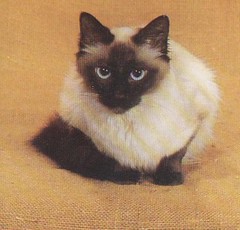 Balinese cat is a long-haired feline breed of oriental origin that is similar to the Siamese. It has the same traits and appearance as the Siamese apart from its flowing long hair. The cats were recognized as early as the initial decades of the twentieth century, in sporadic mutations of Siamese litters. However, it was not until 1950's when its beauty was truly appreciated and development of the breed started in earnest. The name 'Balinese' was given as a depiction of its grace, akin to that of exotic Balinese dancers.
Balinese cat is a long-haired feline breed of oriental origin that is similar to the Siamese. It has the same traits and appearance as the Siamese apart from its flowing long hair. The cats were recognized as early as the initial decades of the twentieth century, in sporadic mutations of Siamese litters. However, it was not until 1950's when its beauty was truly appreciated and development of the breed started in earnest. The name 'Balinese' was given as a depiction of its grace, akin to that of exotic Balinese dancers.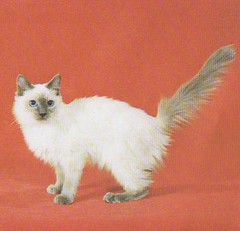 Over the years two variants of the cat have emerged. One is the 'traditional' Balinese with semi-long hair on whole of its body. Other is the 'contemporary' Balinese that has short hair on its body apart from its fluffy tail that has long hair. Both types have the same markings as Siamese cats, their only distinction being their ermine coat. Body is slim, long and muscular. Head is wedge shaped with sapphire eyes somewhat slanted in accordance. Recognized colors are the traditional Siamese blue, chocolate, lilac and seal. Other colors such as red and cream also occur, though such cats are often characterized as Javanese rather than the Balinese.
Over the years two variants of the cat have emerged. One is the 'traditional' Balinese with semi-long hair on whole of its body. Other is the 'contemporary' Balinese that has short hair on its body apart from its fluffy tail that has long hair. Both types have the same markings as Siamese cats, their only distinction being their ermine coat. Body is slim, long and muscular. Head is wedge shaped with sapphire eyes somewhat slanted in accordance. Recognized colors are the traditional Siamese blue, chocolate, lilac and seal. Other colors such as red and cream also occur, though such cats are often characterized as Javanese rather than the Balinese.The silky fur and aristocratic appearance makes the Balinese a sought after breed of felines. They are often considered to be the most intelligent of the longhaired cats. This alongside their single coat that does not get matted nor shed or require constant grooming means they are quite well suited to be the ideal house cat.
Despite their longish hair, the Balinese have a robust physical appearance and are sleek and attractive. Being quite active and playful, they require constant love and attention for their continual intellectual stimulation. At times may gain weight owing to lack of regular exercise. They are on the whole very good pets and companions.
The author is a blogger about cats and an expert on Balinese cats.
Article Source: http://EzineArticles.com/?expert=Omer_Ashraf
Labels:
Balinese
Monday, April 13, 2009
Information Regarding the Singapura Cat
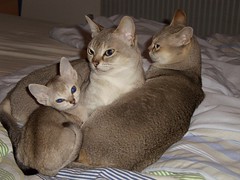 A shorthair feline, Singapura is said to have originated from Singapore. It is thought to have lived there for many years with locals reporting their sightings to go back as far as three centuries. However, it is not the commonest cat in the alleys of Singapore, and is often referred to as the drain or river cat owing to its habit of staying around water bodies in summer months. The cat was imported to United States in nineteen seventies and given championship status in early eighties. There is some controversy regarding the origin of Singapura with some arguing that it is not a natural cat and was artificially bred from Burmese and other cats, particularly with the recent emergence of reports that the genetic makeup of Singapura and Burmese is in fact quite similar. Nevertheless the felid is still recognized as a unique registered breed in most cat fancies across the world.
A shorthair feline, Singapura is said to have originated from Singapore. It is thought to have lived there for many years with locals reporting their sightings to go back as far as three centuries. However, it is not the commonest cat in the alleys of Singapore, and is often referred to as the drain or river cat owing to its habit of staying around water bodies in summer months. The cat was imported to United States in nineteen seventies and given championship status in early eighties. There is some controversy regarding the origin of Singapura with some arguing that it is not a natural cat and was artificially bred from Burmese and other cats, particularly with the recent emergence of reports that the genetic makeup of Singapura and Burmese is in fact quite similar. Nevertheless the felid is still recognized as a unique registered breed in most cat fancies across the world.A relatively tiny animal, Singapura is a small but muscular cat. Both genders weigh in the range of five to seven pounds. General appearance is that of a dainty and somewhat unique feline. Coat is short and in a ticked tabby pattern. Only a sepia brown coloration is seen that is quite similar to the coat of mountain lions. Head is rounded with big expressive eyes that occur in green, yellow or hazed color. Paws are small and tail is normal in length.
Singapuras have all emerged from only a handful of ancestors and therefore they don't have a lot of genetic diversity amongst them. There have been few hereditary illnesses in some of their lines. Since outcrossing is not commonly practiced for these cats, breeders are trying to locate specimens in other parts of the world for induction into the gene pool to add variety.
Singapuras are affectionate cats that spend most of their time playing or staying perched on high places, surveying everything. They follow their humans around everywhere and prefer to be involved in all of their activities. Singapuras are social cats that go along well with everybody, including children, pets and even strangers. They are very gentle and communicate in a soft meow. Sensible animals they don't damage furniture or household items despite their curious and playful nature. Singapuras take time to mature and often it is around two years before they bloom fully into bundles of love and beauty.
The author is a blogger about cats and an expert on Singapura cat.
Article Source: http://EzineArticles.com/?expert=Omer_Ashraf
Labels:
Singapura
Friday, April 10, 2009
Birman - The Facts Every Owner Of This Cat Breed Should Know
 The history of the Birman cat is steeped in mystery. According to legend, the people of Asia built a temple to worship a golden goddess with sapphire-blue eyes. A priest often knelt in meditation with a white temple cat. One night the temple was attacked at the priest killed. As the priest died, the cat placed his feet upon the priest and faced the golden goddess. As he did, the hairs of his white body turned golden, and his yellow eyes to sapphire-blue, his four white legs turned brown, but where his paws rested, they remained white. Where this legend ends, history begins.
The history of the Birman cat is steeped in mystery. According to legend, the people of Asia built a temple to worship a golden goddess with sapphire-blue eyes. A priest often knelt in meditation with a white temple cat. One night the temple was attacked at the priest killed. As the priest died, the cat placed his feet upon the priest and faced the golden goddess. As he did, the hairs of his white body turned golden, and his yellow eyes to sapphire-blue, his four white legs turned brown, but where his paws rested, they remained white. Where this legend ends, history begins.The temple was raided at the beginning of the 20th century. Two westerners, Auguste Pavie and Major Gordon Russell, came to the aid of the priests. As a gesture of gratitude the priests later sent the two men a pair of Birman. The male cat did not survive the trip but the female, who was pregnant, did. The Birman is an average size cat (males generally ranging from eight to twelve pounds, females seven to nine pounds).
Birman - The Facts Every Owner Of This Cat Breed Should Know
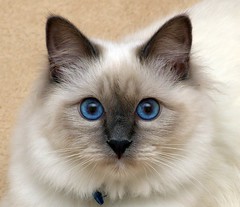 Birmans have a medium length coat that requires very little grooming. The coats are usually a light color on the face and darker over the rest of the coat, with golden shades being the most popular. Their eyes are always blue and their paws are white. Birman coats are long but not very dense, so they are not prone to matting. As the third most popular longhaired cat, Birmans are good pets. They tend to enjoy the company of their human families.
Birmans have a medium length coat that requires very little grooming. The coats are usually a light color on the face and darker over the rest of the coat, with golden shades being the most popular. Their eyes are always blue and their paws are white. Birman coats are long but not very dense, so they are not prone to matting. As the third most popular longhaired cat, Birmans are good pets. They tend to enjoy the company of their human families.Birmans are described as 'soft spoken,' but social and friendly. Birmans are considered sweet and because of this, they are able to adapt well to changes and adore their family. They tend to be a healthy breed; Birmans are generally free from any medical concerns, but some are sensitive to anesthetics. Birmans also require relatively little training and will learn to use the litter box on their own.
There is a website that has great information on Birmans and most other breeds of cats. It has details that pertain to a cat breeds health, grooming, living conditions, best food choices and more, the website is called: Dog And Cat Facts, and can be found at this url:
http://www.dogandcatfacts.com
By Robert W. Benjamin
Copyright © 2007
You may publish this article in your ezine, newsletter, or on your web site as long as it is reprinted in its entirety and without modification except for formatting needs or grammar corrections.
Robert W. Benjamin has been in the software business on the internet for over 5 years, and has been producing low-cost software for the past 25+ years. He first released products on the AMIGA and C64 computer systems in the late 1970's-80's.
Stop The Fleas
http://www.stopthefleas.com
Article Source: http://EzineArticles.com/?expert=Robert_Benjamin
Labels:
Birman
Tuesday, April 7, 2009
The Maine Coon Cat Breed
 Are you a dog lover who wants to own a cat? If so, you may want to take a look at the extraordinary Maine Coon cat breed. This breed is extraordinary intelligent and has a personality that is not exactly cat like. If you think all cats act the same, you probably haven't seen a Maine Coon decide to take a leisurely dip in your family's wading pool.
Are you a dog lover who wants to own a cat? If so, you may want to take a look at the extraordinary Maine Coon cat breed. This breed is extraordinary intelligent and has a personality that is not exactly cat like. If you think all cats act the same, you probably haven't seen a Maine Coon decide to take a leisurely dip in your family's wading pool.The Maine Coon is known as a gentle giant, which is not surprising, since these lovely cats weigh in at anywhere from nine to twenty two pounds. The breed has a squarish face, a thick neck, large ears, big, rounded eyes, and a large, muscular body. The tail is long and quite bushy.
This cat breed was first seen in Maine in the late eighteen hundreds and most likely developed its thick coat as a way to protect itself from the bitterly cold winters in that area. When the breed was first established, only the brown tabby color was recognized. This coat color and the Maine Coon's bushy tail gave it the look of a raccoon, and it is probably this appearance that gave these cats their name. Today, this breed comes in many more recognized colors, including black, blue, cream, red, tortoiseshell, blue tortoiseshell, white, smoke, silver tabby, brown tabby, red tabby, blue tabby, cream tabby, and bicolors. Cats can have green or gold eyes, unless they are white, in which case, eyes can also be blue or mismatched.
The Maine Coon gets along well with other cats, dogs, children, and just about every other type of animal, except mice. This breed is notorious for its excellent hunting abilities. These cats have a wonderful personality and are the perfect cat breed for families. However, they are also content being the only animal in a quiet household.
If you want an extremely quiet cat, then the Maine Coon may not be the perfect choice for you. These cats are a bit on the vocal side. However, the mewling these cats make is a pleasant chirping sound that few people find to be annoying.
With the long coat this breed has, it is no surprise that the Maine Coon needs frequent grooming. You should be prepared to thoroughly comb out your cat's coat at least twice a week. If the coat begins to develop knots and snarls, you may need to groom him even more frequently.
Overall, this descendant of hardy farm cats is a healthy breed. If your cat seems to be feeling under the weather, he most likely has a hairball problem. Of course, you should seek veterinary care to be sure he does not have any more serious problems. While you are talking to your veterinarian, you may want to consult him about feeding your cat a cat food with hairball control.
Since the Maine Coon is said to be the most popular breed in the world, it would be no surprise if you decided that you wanted to own one of these beautiful animals. If you want an intelligent and loving cat, this breed may be the perfect choice for you.
I would love to share my secrets with you and my new special articles on cat training do just that! Everything you need to know to train your cat is included in these special reports: See our section on Cat Breads.
Article Source: http://EzineArticles.com/?expert=Neil_Groom
Labels:
Maine Coon
Monday, April 6, 2009
Ragdoll Cats - An Unusual Cat Breed
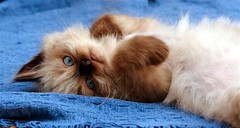
The Ragdoll cat breed has an unusual history. According to one story, aliens brought this cat here; a cat that gets its name from the way it goes limp like a Ragdoll when you pick one up.
The Ragdoll cat breed originated in Riverside, California in the 1960s; the breed was founded by an eccentric woman named Ann Baker. The very first Ragdoll cat was a Persian-Birman mix named Josephine. Ragdoll cats come in a variety of colors today, including blue, bicolor, color point, torte, mink, and lynx.
The Ragdoll cat is the largest breed of domestic cat; males can weigh in over twenty pounds when fully mature. Ragdolls are registered by all of the major cat associations and recognized as a purebred cat.
Ragdoll cats are easy going and best known for their characteristic limpness when held. They have medium longhair coats and shed very little for having coats of this length. Ragdolls are very low maintenance cats; they have silky rabbit like fur and do most of their grooming themselves. Because of their size, Ragdoll cats tend to be slightly clumsy; these cats do not typically make good mousers, they are just too laid back to care about mice. Many Ragdoll cats exhibit dog-like behaviors; for example, this breed will run to the door to greet you upon returning home.
Part of what makes this cat so unusual are the stories Ann Baker told about its origins. On one account Ann Baker claimed here new breed of cat was brought here by aliens; another account states the breed was genetically engineered by the government.
Alien or government conspiracy aside, the Ragdoll has quickly become one of the most popular breeds of cat available today.
Ben Harper is a Ragdoll cat enthusiast and founder of the site Ragdoll Cats which was established to promote the Ragdoll cat breed. To learn more about this unusual cat visit: http://www.ragdollcats.info
Article Source: http://EzineArticles.com/?expert=Ben_Harper
Labels:
Ragdoll
Friday, April 3, 2009
Subscribe to:
Posts (Atom)
